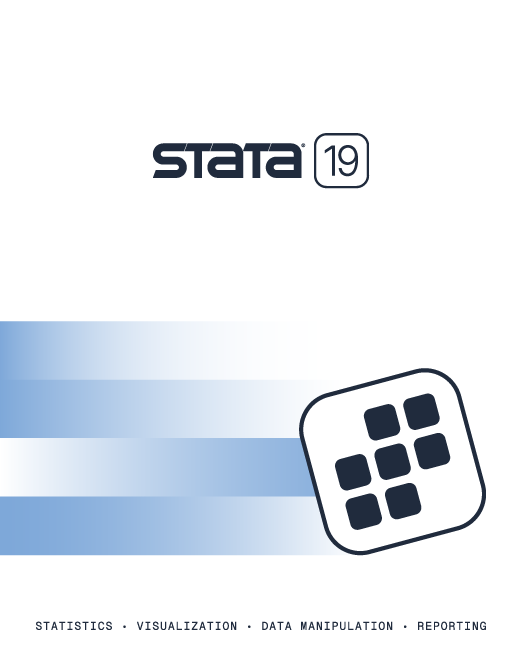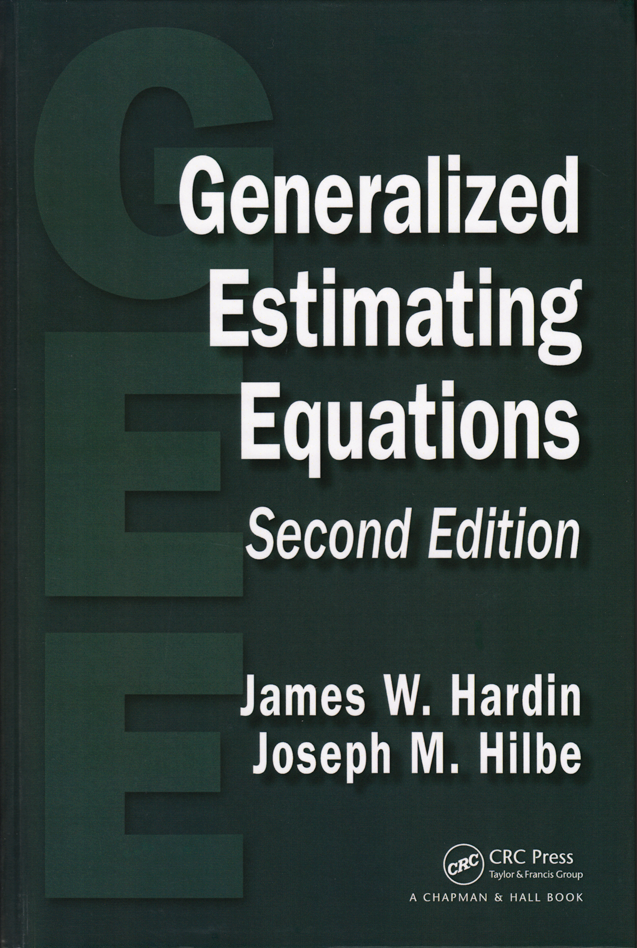

2025 Stata Conference • Nashville, TN • 31 July–01 August
Generalized Estimating Equations, Second Edition |
||||||||||||||||||||||||||||||||||||
 Click to enlarge See the back cover |

As an Amazon Associate, StataCorp earns a small referral credit from
qualifying purchases made from affiliate links on our site.
eBook not available for this title
eBook not available for this title |
Review of the first edition from the Stata Journal |
||||||||||||||||||||||||||||||||||
Comment from the Stata technical groupThe method of generalized linear models (GLM) is an integral part of the data analyst’s toolkit, as it encompasses many models under one roof: logistic and probit regressions, ordinary least squares, ordinal outcome regression, and regression models for the analysis of survival data, to name a few. Nominal GLM, however, is inadequate when the data are longitudinal or are otherwise grouped so that observations within the same group are expected to be correlated. The method of generalized estimating equations (GEE) is a generalization of GLM that takes into account this within-group correlation. This text is the sequel to the 2001 text, Generalized Linear Models and Extensions, by the same authors, and provides the first complete treatment of GEE methodology. As with the previous text on GLM, this text is filled with examples on using this methodology with Stata. In fact, the principal author, James Hardin, developed much of the Stata software for fitting GEE models while he was a senior statistician at StataCorp. This text is heavy in mathematical and computational detail, but the mathematics is balanced by an array of real-world datasets and analyses. Thus the text should appeal to a wide audience, from the mathematical statistician wishing to glean the current state of the GEE literature to the professional researcher needing to fit a GEE model to solve a particular problem. The second edition includes material about estimation of GEEs for survival analysis and robust variance estimates, as well as additional model-selection tools. Additional program code has also been included. |
||||||||||||||||||||||||||||||||||||
Table of contentsView table of contents >> Preface
1 Introduction
1.1 Notational conventions and acronyms
1.2 A short review of generalized linear models
1.2.1 A brief history of GLMs
1.3 Software
1.2.1.1 GLMs as likelihood-based models
1.2.2 GLMs and overdispersed data 1.2.1.2 GLMs and correlated data
1.2.2.1 Scaling standard errors
1.2.3 The basics of GLMs 1.2.2.2 The modified sandwich variance estimator 1.2.4 Link and variance functions 1.2.5 Algorithms
1.3.1 R
1.4 Exercises 1.3.2 SAS 1.3.3 Stata 1.3.4 SUDAAN 2 Model Construction and Estimating Equations
2.1 Independent data
2.1.1 Optimization
2.2 Estimating the variance of the estimates 2.1.2 The FIML estimating equation for linear regression 2.1.3 The FIML estimating equation for Poisson regression 2.1.4 The FIML estimating equation for Bernoulli regression 2.1.5 The LIML estimating equation for GLMs 2.1.6 The LIMQL estimating equation for GLMs
2.2.1 Model-based variance
2.3 Panel data 2.2.2 Empirical variance 2.2.3 Pooled variance
2.3.1 Pooled estimators
2.4 Estimation 2.3.2 Fixed-effects and random-effects models
2.3.2.1 Unconditional fixed-effects models
2.3.3 Population-averaged and subject-specific models 2.3.2.2 Conditional fixed-effects models 2.3.2.3 Random-effects models 2.5 Summary 2.6 Exercises 2.7 R code for selected output 3 Generalized Estimating Equations
3.1 Population-averaged (PA) and subject-specific (SS) models
3.2 The PA-GEE for GLMs
3.2.1 Parameterizing the working correlation matrix
3.3 The SS-GEE for GLMs
3.2.1.1 Exchangeable correlation
3.2.2 Estimating the scale variance (dispersion parameter) 3.2.1.2 Autoregressive correlation 3.2.1.3 Stationary correlation 3.2.1.4 Nonstationary correlation 3.2.1.5 Unstructured correlation 3.2.1.6 Fixed correlation 3.2.1.7 Free specification
3.2.2.1 Independence models
3.2.3 Estimating the PA-GEE model 3.2.2.2 Exchangeable models 3.2.4 The robust variance estimate 3.2.5 A historical footnote 3.2.6 Convergence of the estimation routine 3.2.7 ALR: Estimating correlations for binomial models 3.2.8 Quasi-least squares 3.2.9 Summary
3.3.1 Single random-effects
3.4 The GEE2 for GLMs 3.3.2 Multiple random-effects 3.3.3 Applications of the SS-GEE 3.3.4 Estimating the SS-GEE model 3.3.5 Summary 3.5 GEEs for extensions of GLMs
3.5.1 Multinomial logistic GEE regression
3.6 Further developments and applications 3.5.2 Proportional odds GEE regression 3.5.3 Penalized GEE models 3.5.4 Cox proportional hazards GEE models
3.6.1 The PA-GEE for GLMs with measurement error
3.7 Missing data 3.6.2 The PA-EGEE for GLMs 3.6.3 The PA-REGEE for GLMs 3.6.4 Quadratic inference function for marginal GLMs 3.8 Choosing an appropriate model 3.9 Marginal effects
3.9.1 Marginal effects at the means
3.10 Summary 3.9.2 Average marginal effects 3.11 Exercises 3.12 R code for selected output 4 Residuals, Diagnostics, and Testing
4.1 Criterion measures
4.1.1 Choosing the best correlation structure
4.2 Analysis of residuals 4.1.2 Alternatives to the original QIC 4.1.3 Choosing the best subset of covariates
4.2.1 A nonparametric test of the randomness of residuals
4.3 Deletion diagnostics 4.2.2 Graphical assessment 4.2.3 Quasivariance functions for PA-GEE models
4.3.1 Influence measures
4.4 Goodness of fit (population-averaged models) 4.3.2 Leverage measures
4.4.1 Proportional reduction in variation
4.5 Testing coefficients in the PA-GEE model 4.4.2 Concordance correlation 4.4.3 A χ2 goodness of fit test for PA-GEE binomial models
4.5.1 Likelihood ratio tests
4.6 Assessing the MCAR assumption of PA-GEE models 4.5.2 Wald tests 4.5.3 Score tests 4.7 Summary 4.8 Exercises 5 Programs and Datasets
5.1 Programs
5.1.1 Fitting PA-GEE models in Stata
5.2 Datasets
5.1.2 Fitting PA-GEE models in SAS 5.1.3 Fitting PA-GEE models in R 5.1.4 Fitting ALR models in SAS 5.1.5 Fitting PA-GEE models in SUDAAN 5.1.6 Calculating QIC(P) in Stata 5.1.7 Calculating QIC(HH) in Stata 5.1.8 Calculating QICu in Stata 5.1.9 Graphing the residual runs test in R 5.1.10 Using the fixed correlation structure in Stata 5.1.11 Fitting quasivariance PA-GEE models in R 5.1.12 Fitting GLMs in R 5.1.13 Fitting FE models in R using the GAMLSS package 5.1.14 Fitting RE models in R using the LME4 package
5.2.1 Wheeze data
5.2.2 Ship accident data 5.2.3 Progabide data 5.2.4 Simulated logistic data 5.2.5 Simulated user-specified correlated data 5.2.6 Simulated measurement error data for the PA-GEE References
Author index
Subject index
|
||||||||||||||||||||||||||||||||||||
Learn
Free webinars
NetCourses
Classroom and web training
Organizational training
Video tutorials
Third-party courses
Web resources
Teaching with Stata
© Copyright 1996–2025 StataCorp LLC. All rights reserved.
×
We use cookies to ensure that we give you the best experience on our website—to enhance site navigation, to analyze usage, and to assist in our marketing efforts. By continuing to use our site, you consent to the storing of cookies on your device and agree to delivery of content, including web fonts and JavaScript, from third party web services.
Cookie Settings
Last updated: 16 November 2022
StataCorp LLC (StataCorp) strives to provide our users with exceptional products and services. To do so, we must collect personal information from you. This information is necessary to conduct business with our existing and potential customers. We collect and use this information only where we may legally do so. This policy explains what personal information we collect, how we use it, and what rights you have to that information.
These cookies are essential for our website to function and do not store any personally identifiable information. These cookies cannot be disabled.
This website uses cookies to provide you with a better user experience. A cookie is a small piece of data our website stores on a site visitor's hard drive and accesses each time you visit so we can improve your access to our site, better understand how you use our site, and serve you content that may be of interest to you. For instance, we store a cookie when you log in to our shopping cart so that we can maintain your shopping cart should you not complete checkout. These cookies do not directly store your personal information, but they do support the ability to uniquely identify your internet browser and device.
Please note: Clearing your browser cookies at any time will undo preferences saved here. The option selected here will apply only to the device you are currently using.